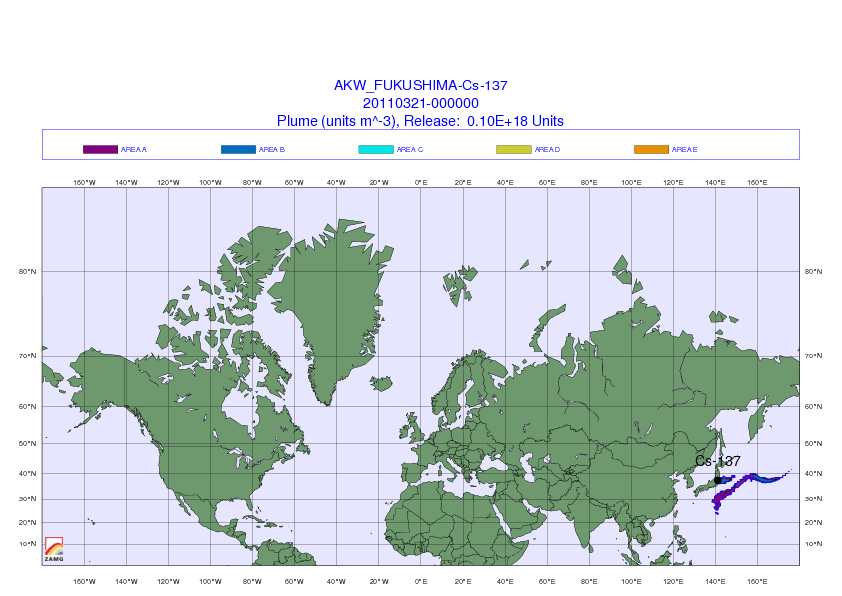
Cesium Fallout from Fukushima-Daiichi ALREADY Rivals Chernobyl....
Listening to these experts makes me wonder whether the western corporate media is, yet again, engaging in another cover-up to protect its corporate and political bosses...
To get a good idea of the real extend of the damage suffered by the Fukushima nuclear plant please click here for some high resolution overhead pictures.
Many experts say that the Fukushima plants will keep on leaking for months. See this and this.
And the amount of radioactive fuel at Fukushima dwarfs Chernobyl....
As the New York Times notes, radioactive cesium is the main danger from the Japanese nuclear accident:
But anyone who believes that Fukushima cannot possibly become as bad as Chernobyl has no idea what they are talking about.
And the amount of radioactive fuel at Fukushima dwarfs Chernobyl....
As the New York Times notes, radioactive cesium is the main danger from the Japanese nuclear accident:
Over the long term, the big threat to human health is cesium-137, which has a half-life of 30 years.So it is bad news indeed that, as reported by New Scientist, cesium fallout from Fukushima already rivals Chernobyl:
At that rate of disintegration, John Emsley wrote in “Nature’s Building Blocks” (Oxford, 2001), “it takes over 200 years to reduce it to 1 percent of its former level.”
It is cesium-137 that still contaminates much of the land in Ukraine around the Chernobyl reactor.
***
Cesium-137 mixes easily with water and is chemically similar to potassium. It thus mimics how potassium gets metabolized in the body and can enter through many foods, including milk.
Radioactive caesium and iodine has been deposited in northern Japan far from the Fukushima Daiichi nuclear plant, at levels that were considered highly contaminated after Chernobyl.The readings were taken by the Japanese science ministry, MEXT, and reveal high levels of caesium-137 and iodine-131 outside the 30-kilometre evacuation zone, mostly to the north-north-west.***After the 1986 Chernobyl accident, the most highly contaminated areas were defined as those with over 1490 kilobecquerels (kBq) of caesium per square metre. Produce from soil with 550 kBq/m2 was destroyed.People living within 30 kilometres of the plant have evacuated or been advised to stay indoors. Since 18 March, MEXT has repeatedly found caesium levels above 550 kBq/m2 in an area some 45 kilometres wide lying 30 to 50 kilometres north-west of the plant. The highest was 6400 kBq/m2, about 35 kilometres away, while caesium reached 1816 kBq/m2 in Nihonmatsu City and 1752 kBq/m2 in the town of Kawamata, where iodine-131 levels of up to 12,560 kBq/m2 have also been measured. "Some of the numbers are really high," says Gerhard Proehl, head of assessment and management of environmental releases of radiation at the International Atomic Energy Agency.
While Japan has been exposed to very high levels of cesium, so far, the levels of cesium in other parts of the world appear to be relatively low:
And see this.But anyone who believes that Fukushima cannot possibly become as bad as Chernobyl has no idea what they are talking about.
Regarding the animation in the blue square:
it was done by the "Rhenish Institute for Environmental Research at the University of Cologne" in Germany.
In the report it states: "The release rate is estimated as 1015 Bq/d. This is approximately one tenth of the Chernobyl release. This simulation is a so called "worst case scenario" with continuous release rate. The value of 0.001 Bq/m3 correspond to approximately one millionth of the concentration at the source. At distances more than approximately 2000 km away from the source, the concentrations are not harmful to health."
Check: http://www.eurad.uni-koeln.de/index_e.html
for the direct link as updates will occur as data becomes available.
...
.
How high is the radiation from Japan's leaking Fukushima Daiichi complex?
People have measured very high levels of radiation some 40 killometers from Fukushima:
The Japan Times reports that there are extremely high levels of radiation in and around the nuclear plants:
...
Radiation Effects on Humans - CHART - micro (µ) and milli Sieverts (mSv)
.
How high is the radiation from Japan's leaking Fukushima Daiichi complex?
People have measured very high levels of radiation some 40 killometers from Fukushima:
The Japan Times reports that there are extremely high levels of radiation in and around the nuclear plants:
Radioactive iodine-131 readings taken from seawater near the water intake of the Fukushima No. 1 nuclear plant's No. 2 reactor reached 7.5 million times the legal limit, Tokyo Electric Power Co. admitted Tuesday.
The sample that yielded the high reading was taken Saturday, before Tepco announced Monday it would start releasing radioactive water into the sea [see this for background], and experts fear the contamination may spread well beyond Japan's shores to affect seafood overseas.The unstoppable radioactive discharge into the Pacific has prompted experts to sound the alarm, as cesium, which has a much longer half-life than iodine, is expected to concentrate in the upper food chain.According to Tepco, some 300,000 becquerels per sq. centimeter of radioactive iodine-131 was detected Saturday, while the amount of cesium-134 was 2 million times the maximum amount permitted and cesium-137 was 1.3 million times the amount allowable.***The level of radioactive iodine in the polluted water inside reactor 2's cracked storage pit had an even higher concentration. A water sample Saturday had 5.2 million becquerels of iodine per sq. centimeter, or 130 million times the maximum amount allowable, and water leaking from the crack had a reading of 5.4 million becquerels, Tepco said.
***Masayoshi Yamamoto, a professor of radiology at Kanazawa University, said the high level of cesium is the more worrisome find."By the time radioactive iodine is taken in by plankton, which is eaten by smaller fish and then by bigger fish, it will be diluted by the sea and the amount will decrease because of its eight-day half-life," Yamamoto said. "But cesium is a bigger problem."The half-life of cesium-137 is 30 years, while that for cesium-134 is two years. The longer half-life means it will probably concentrate in the upper food chain.Yamamoto said such radioactive materials are likely to be detected in fish and other marine products in Japan and other nations in the short and long run, posing a serious threat to the seafood industry in other nations as well.
And NHK news points out that radiation levels are so high in some locations that they are literally "immeasurable":
A radiation monitor at the troubled Fukushima Daiichi nuclear power plant says workers there are exposed to immeasurable levels of radiation.
The monitor told NHK that no one can enter the plant's No. 1 through 3 reactor buildings because radiation levels are so high that monitoring devices have been rendered useless. He said even levels outside the buildings exceed 100 millisieverts in some places.
Amount of radiation in 3 gallons of milk from Hilo, Hawaii surpasses annual maximum contaminant level set by EPA
Japan raises Fukushima to Level 7, same as Chernobyl
http://www.youtube.com/watch?v=DZnIr14v0zw&feature=player_embedded
Vietnam finds Uranium-238 in sample of pine needles — 4,000 km away from Fukushima
100 miles from Fukushima: Leak from spent fuel pools at two reactors after 7.4 quake — Cooling system temporarily stopped
This is now the Onagawa power plant closer to Tokyo losing cooling and leaking radiation.
Japanese Experts: Effort is in danger of failing… and reactors too hot to cover in concrete — TEPCO admits there is no end in sight





